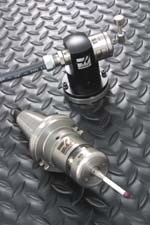System Simplifies Probing Operations On VMCs
Few machinists will dispute the merits of probing for speeding part setup, setting tool offsets and performing in-process inspection . . . at least in theory. In practice, however, probe systems often have been viewed as difficult to use and expensive to buy.
Share



Few machinists will dispute the merits of probing for speeding part setup, setting tool offsets and performing in-process inspection . . . at least in theory. In practice, however, probe systems often have been viewed as difficult to use and expensive to buy. As a result, they've become tools used primarily by experienced programmers in high-production environments.
The Visual Quick Code probing system from Haas Automation, Inc. (Oxnard, California) is designed to make probing effective and more affordable to a wide range of users. The system was recently developed in conjunction with Renishaw, a leader in probe systems.
Available as an option on new Haas vertical machining centers, the system consists of a spindle probe, a contact tool setting probe, an optical receiver and Renishaw's Inspection Plus software. The system is installed and calibrated at the machine tool builder's factory.
The system features a conversational programming system that uses a graphical interface and a question/answer format to create G-code programs. It does not require knowledge of macro programming. The machinist creates probe routines for tool setting and part setup by entering basic information with the keyboard on the CNC.
For example, to probe the external corner of a workpiece and establish a work offset, the machinist selects the appropriate graphical template, jogs the spindle probe to within 0.5 inch of the selected corner and enters the following information: work offset number (for example, G54), approximate X width of the material, approximate Y width of the material and which corner to probe. Once this information is entered, a pop-up dialog box prompts the machinist to choose where to output the G code: to a new program, to an existing program or directly to manual data input (MDI). Once a destination is selected, the G code is generated automatically for the probe routine.
If the G code is used as direct data input, the machinist hits Cycle Start to probe the workpiece and automatically enter the correct offsets into the control. If the machinist chooses to create a new program, the program can be called up immediately to start the probe routine, or saved for later use. If the G code is inserted into an existing part program, it can be used to probe each workpiece and update the offsets prior to machining.
The system also has templates for finding the center of a workpiece, probing a bore or boss, measuring bore-to-bore or boss-to-boss and probing a web or pocket.
The procedure for setting tool offsets follows a pattern very similar to the procedure for setting work offsets, with templates for automatically measuring tool length, tool diameter or both. The machinist can measure tools individually or create a probe routine to check a carousel of tools.
The company points out that despite the very favorable pricing, the system is considered a full-featured, high-resolution probe system capable of many other probing tasks in addition to tool and part setting. Using macros (included) and advanced programming methods, it can perform such operations as in-process tool and part inspection, first-off part measurement, automatic compensation for thermal changes and checking for worn or broken tools. This functionality reduces operator-induced variations in the process and builds confidence in unattended machining processes.
Related Content
How to Successfully Adopt Five-Axis Machining
While there are many changes to adopt when moving to five-axis, they all compliment the overall goal of better parts through less operations.
Read More4 Tips for Staying Profitable in the Face of Change
After more than 40 years in business, this shop has learned how to adapt to stay profitable.
Read MoreThe Future of High Feed Milling in Modern Manufacturing
Achieve higher metal removal rates and enhanced predictability with ISCAR’s advanced high-feed milling tools — optimized for today’s competitive global market.
Read More4 Commonly Misapplied CNC Features
Misapplication of these important CNC features will result in wasted time, wasted or duplicated effort and/or wasted material.
Read MoreRead Next
OEM Tour Video: Lean Manufacturing for Measurement and Metrology
How can a facility that requires manual work for some long-standing parts be made more efficient? Join us as we look inside The L. S. Starrett Company’s headquarters in Athol, Massachusetts, and see how this long-established OEM is updating its processes.
Read More

















-02.jpg;maxWidth=300;quality=90)









